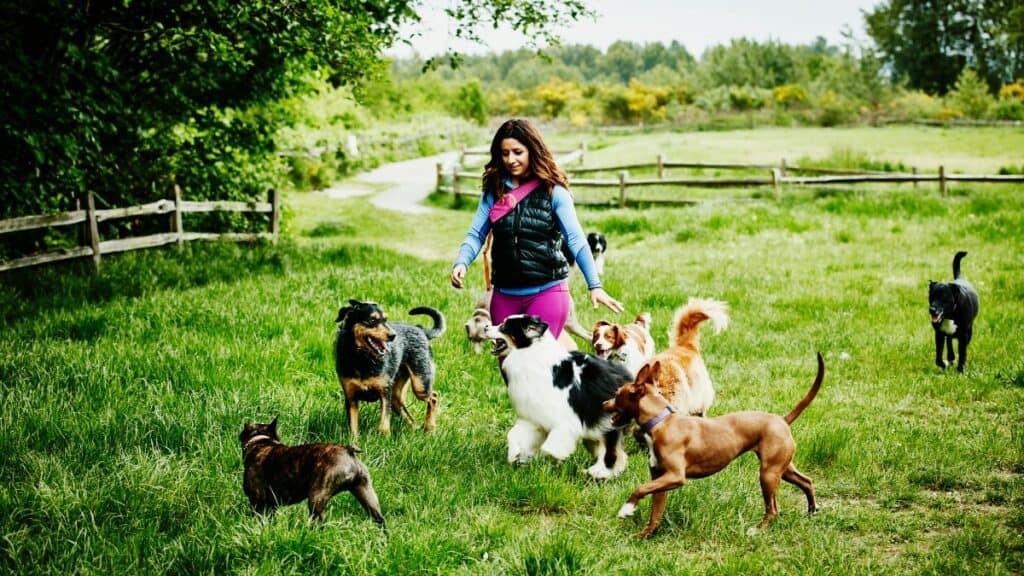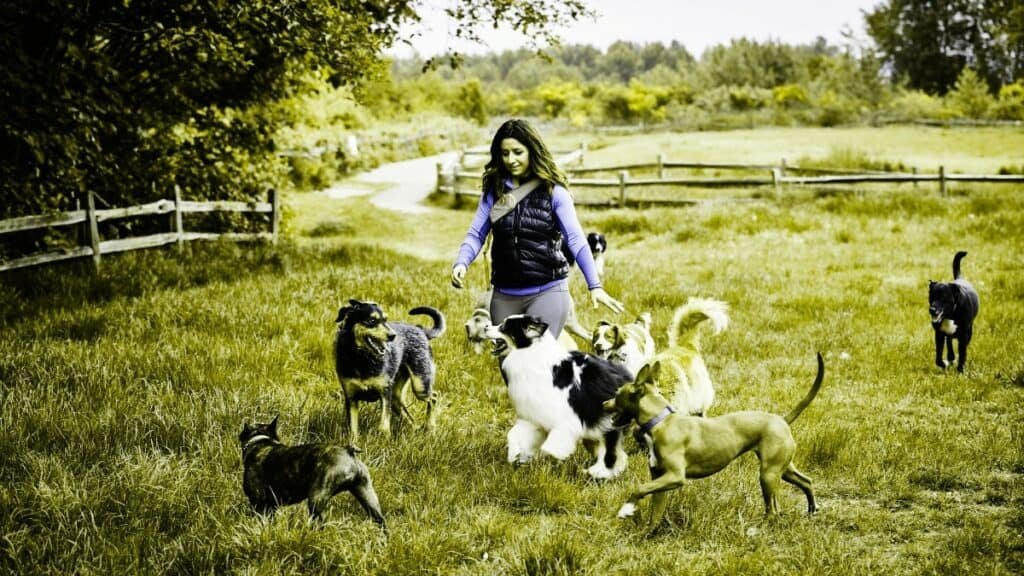Have you ever gazed into the eyes of your loyal canine companion and wondered how they perceive the vibrant world around them? While many believe that dogs see in black and white, the truth is far more colorful.
Let’s delve into the affectionate world of our four-legged friends and uncover the spectrum of colors they truly see


Choosing the right toy color can make playtime more engaging for dogs, as they gravitate towards blues and yellows.
The Canine Color Palette
Dogs, unlike humans, experience the world of color differently. Their perception, while unique, offers a fascinating insight into how they interact with their surroundings.
Dogs Have Dichromatic Vision
Dogs possess dichromatic vision, which means they primarily see two main colors: blue and yellow. While humans have trichromatic vision, allowing us to see a wide spectrum of colors, dogs’ vision is more limited but still colorful in its own right.
This dichromatic vision is attributed to the two types of cone cells in a dog’s retina. These cones allow them to perceive shades of blue and yellow. However, they lack the cone that detects red and green, which is present in humans.
Comparison with Humans
Imagine looking at a rainbow but only being able to distinctly identify the shades of blue and yellow, with the rest appearing as variations of these or as grayish hues. That’s somewhat close to how dogs perceive the world.
Reds, to dogs, don’t appear as the vibrant color we see. Instead, they might see it as a shade of gray or brown. Similarly, green, which is so vivid to human eyes, might appear as a form of yellow to our canine companions.
This difference in color perception doesn’t mean dogs see a less vibrant world; it’s just different from ours. Their world is a palette of blues, yellows, and grays.
Practical Implications for Dog Parents
Understanding the canine color palette can be beneficial for dog owners. For instance, if you’re buying toys for your dog, they might be more attracted to a bright blue or yellow toy compared to a red or green one.
Similarly, if you’re training your dog and using colored signals or cues, it’s essential to know which colors they can see clearly. This knowledge ensures better communication and understanding between you and your furry friend.


In a colorful garden, dogs see the world differently, with reds appearing gray and greens taking on a yellow hue.
The Science Behind Their Unique Sight
The world of canine vision is a blend of biology and evolution, tailored to their needs as hunters, gatherers, and companions. To truly understand what colors dogs see, we must dive into the anatomy and function of their eyes.
Rods and Cones
Just like humans, dogs have rods and cones in their retinas. These are photoreceptor cells responsible for vision.
Rods: These cells are more abundant in dogs than in humans. They are responsible for low-light vision, which explains why dogs excel in dimly lit conditions. The high number of rod cells gives them superior night vision and motion detection, essential traits for their ancestral hunting habits.
Cones: These cells detect color. While humans have three types of cones (red, blue, and green), dogs only have two (blue and yellow). This dichromatic vision is why dogs perceive a different color spectrum than we do.
The Limitations and Strengths of Your Dog’s Vision
While dogs might not see the full spectrum of colors, their vision has its strengths. Their night vision is far superior to ours, and they can detect even the slightest movement, making them excellent guards and hunters.
Their dichromatic vision, though limited in color perception, is incredibly sharp in terms of brightness discrimination. This ability allows them to notice even subtle changes in light, which can be crucial in various scenarios, from hunting to detecting threats.


While humans see a spectrum of colors in a rainbow, dogs perceive it with a focus on blues, yellows, and grays.
Practical Implications for Dog Owners
Understanding the nuances of canine color vision isn’t just a fascinating scientific endeavor; it has real-world implications for dog owners. By grasping how dogs perceive their environment, we can make more informed decisions about their care, training, and entertainment.
Toy Selection
When choosing toys for your dog, color matters. Since dogs can see blue and yellow more vividly, toys in these colors might be more appealing to them. A bright blue ball or a yellow squeaky toy can stand out in their vision, making playtime more engaging.
Conversely, toys in shades of red or green might not be as visually stimulating for dogs. They might appear as muted browns or grays, blending into the background, especially if played with on green grass.
Training Aids
If you’re using colored signals or cues during training, it’s crucial to pick colors that your dog can easily distinguish. For instance, using a blue training disc or a yellow flag can be more effective than a red one.
Additionally, understanding that dogs are more sensitive to changes in brightness can help in training scenarios. Using high contrast aids, regardless of their color, can be beneficial.
Safety Considerations
For nighttime walks or outings, using a blue or yellow reflective collar or leash can make your dog more visible, not just to you but also to others who might be familiar with canine color vision.
Similarly, if you have a fenced yard or a designated play area, using blue or yellow markers or flags can help your dog recognize boundaries more clearly.
Home Environment
If you’re designing a space specifically for your dog, like a playroom or a kennel, consider their color vision. Blue and yellow furnishings or play mats can create a visually stimulating environment for them.
For puzzle toys or interactive feeders, those that contrast sharply with their surroundings (in terms of brightness) can be more engaging for dogs, even if they aren’t specifically blue or yellow.


A dog's perspective on human and canine colors, emphasizing their unique color perspective.
Debunking Common Dog Vision Myths
The world of canine vision is rife with misconceptions. Many beliefs about how dogs see have been passed down through generations, leading to a mix of fact and fiction. Let’s address some of the most common myths and set the record straight.
Myth 1: Dogs See Only in Black and White
The Reality: One of the most prevalent myths is that dogs see the world in grayscale. While it’s true that their color spectrum is limited compared to humans, it’s far from just black and white. As we’ve established, dogs primarily see shades of blue and yellow. So, while their world might not be as colorful as ours, it’s certainly not monochromatic.
Myth 2: Dogs Have Poor Vision
The Reality: Some believe that because dogs rely heavily on their sense of smell, their vision must be inferior. While it’s true that their sense of smell is extraordinary, their vision is by no means poor. Dogs have evolved to have excellent motion detection and low-light vision, making them adept at spotting movement even in dim conditions.
Myth 3: All Dogs See the Same
The Reality: Just as human vision can vary, so can canine vision. Factors like age, breed, and health can influence how a dog sees. For instance, older dogs might experience vision impairments, and certain breeds might have slightly different visual capabilities due to the physical structure of their eyes.
Myth 4: Color Doesn’t Matter to Dogs
The Reality: While color might not play as pivotal a role for dogs as it does for humans, it’s not irrelevant. As we’ve discussed, dogs might prefer toys or respond better to training aids of certain colors. Recognizing their color preferences can enhance their play and learning experiences.
Myth 5: Dogs’ Night Vision is a Result of Color Perception
The Reality: Some might believe that dogs’ impressive night vision is tied to their color perception. In reality, their night vision is due to the high number of rod cells in their retinas and the presence of the tapetum lucidum, a layer that reflects light back through the retina. This has little to do with their color vision.
In conclusion, understanding the truth behind these myths not only deepens our knowledge of canine vision but also fosters a more informed and empathetic relationship with our four-legged companions. By debunking these misconceptions, we can better appreciate the unique way our dogs perceive the world and cater to their needs more effectively.
Breed Variations: A Spectrum of Sight
While all dogs have dichromatic vision, meaning they primarily see two colors (yellow and blue), the intensity and clarity with which they perceive these colors can vary based on the breed. Several factors, including the size of the eye, the arrangement of the retina, and genetic factors, can influence a breed’s vision.
- Siberian Husky: Known for their striking blue eyes, Siberian Huskies have a unique retinal arrangement. While they still see the world in shades of blue and yellow, some believe that their perception of blue might be slightly more intense than other breeds.
- German Shepherds: Bred for herding and guarding, German Shepherds have keen eyesight. Their vision is adapted to detect motion, and while their color perception aligns with the typical dog’s, their ability to detect movement in their peripheral vision is exceptional.
- Dachshunds: Originally bred for hunting small animals, Dachshunds have eyes that are adapted to detect movement in lower light conditions. This might mean that while their color vision is standard, they can discern these colors better in dimly lit environments.
- Greyhounds: As racing dogs, Greyhounds have a broader field of vision than many other breeds. This panoramic view helps them spot other dogs on the track. While their color perception is typical, their ability to perceive motion across a wide field is unparalleled.
- Labrador Retrievers: Labs, especially those with lighter eyes, might have a slightly different color perception. Some anecdotal evidence suggests that Labs might be more responsive to shades of blue, making blue toys particularly appealing to them.
- Pugs: Due to their prominent eyes, Pugs might have a slightly different visual field. While this doesn’t necessarily affect their color perception, it might influence how they perceive the intensity of colors, especially in bright light.
While the basic structure of the canine eye remains consistent across breeds, the nuances of their vision can vary. Factors like the breed’s original purpose (hunting, herding, guarding) and their genetic makeup can influence not just how they see colors but also how they interpret movement and light. It’s always fascinating to consider how each breed might have a slightly unique way of viewing the world.
Test Your Dog Vision Expertise!
Frequently Asked Questions About Dog Vision
Are dogs completely colorblind?
No, dogs are not completely colorblind. They primarily see two colors: yellow and blue.
Why can’t dogs see as many colors as humans?
Dogs have only two types of color receptors (cones) in their eyes, compared to humans who have three. This limits their color vision to dichromatic, while humans have trichromatic vision.
How do dogs perceive the color red?
Dogs typically see the color red as a shade of gray or brown. They don’t perceive red the same way humans do.
What about green? How do dogs see it?
Greens usually appear as shades of yellow to dogs.
Why do dogs have better night vision than humans?
Dogs have more rod cells in their eyes, which are responsible for low-light vision. This makes them more adept at seeing in dimly lit conditions.
Is it true that certain dog breeds see colors differently?
While all dogs have dichromatic vision, some breeds may have slight variations in their vision due to the structure of their eyes and other genetic factors.
How can I choose toys that my dog can see best?
Opt for toys that are blue or yellow, as these colors are most vivid in a dog’s vision.
Do dogs prefer certain colors over others?
While dogs don’t have color preferences in the same way humans do, they might be more responsive to toys or objects that are blue or yellow since they can see these colors more clearly.
How does a dog’s color vision affect their daily life?
While color vision plays a role, dogs rely more on their sense of smell and hearing. However, understanding their color perception can help owners make better choices for toys, training aids, and safety gear.
Are there any tests to determine how my dog sees colors?
While there’s no definitive test for canine color vision, observing your dog’s reactions to different colored toys or objects can give you some insights.
Why do some dogs’ eyes glow in the dark?
The glow is due to a layer in the dog’s eyes called the tapetum lucidum, which reflects light and enhances their night vision.
If dogs can’t see red, why do they react to red objects or toys?
Dogs might react to the brightness and contrast of the object against its background, rather than the color itself. They also rely heavily on other senses, like smell and texture.
Our affectionate canine companions might not see the world as colorfully as we do, but they have their unique way of perceiving their surroundings. By understanding their vision, we can better cater to their needs and strengthen the bond we share with these loyal creatures.





















